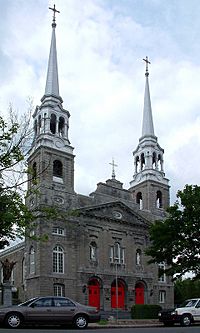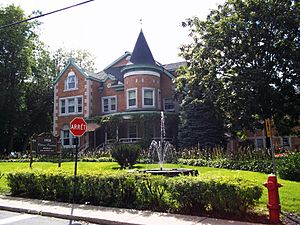Sainte-Geneviève, Quebec facts for kids
Quick facts for kids
Sainte-Geneviève
|
|
|---|---|
|
Neighbourhood
|
|

Église Sainte-Geneviève
|
|

Map of Sainte-Geneviève
|
|
| Country | |
| Province | |
| City | |
| Borough | L'Île-Bizard–Sainte-Geneviève |
| Area | |
| • Land | 0.86 km2 (0.33 sq mi) |
| Population
(2011)
|
|
| • Total | 3,450 |
| • Density | 4,020/km2 (10,400/sq mi) |
| • Change (2006-2011) | |
| • Dwellings (2011) | 1,648 |
| Time zone | UTC-5 (Eastern (EST)) |
| • Summer (DST) | UTC-4 (EDT) |
| Postal code span |
H9H
|
| Area code(s) | (514) and (438) |
Sainte-Geneviève used to be a small town on the Island of Montreal in Quebec, Canada. Today, it's a neighborhood within the City of Montreal. It is part of the L'Île-Bizard–Sainte-Geneviève borough. This change happened on January 1, 2002.
This charming neighborhood has many traditional Quebec-style homes and old mansions. It sits on the northwest side of the Island of Montreal. You can find it along Gouin Boulevard, looking out over the Rivière des Prairies. Across the river to the north is Île Bizard. Sainte-Geneviève is surrounded by what used to be the town of Pierrefonds on its west, south, and east sides.
Two important landmarks in Sainte-Geneviève are the Cégep Gérald-Godin and the Église Sainte-Geneviève. The church was built in 1844. It was designed by a famous Quebec architect named Thomas Baillargé.
Contents
History of Sainte-Geneviève
How the Parish Began
After the Great Peace of Montreal was signed in 1701, French settlers called habitants could move to the western part of the Island of Montreal. In 1720, a road was built, and the Sulpicians, a religious group, mapped the area.
In 1739, the Roman Catholic Archdiocese of Quebec allowed a new church area, called a parish, to be set up. It was named after Saint Geneviève. A small church, or chapel, was finished the next year. The first main church building was constructed in 1751. The church building you see today was built between 1843 and 1847.
Becoming a Civil Parish
The civil parish of Sainte-Geneviève was officially created in 1845. It was named after the church. On June 9, 1859, it became known as the Municipality of the Village of Sainte-Geneviève. In 1893, a bridge called the Jacques Bizard Bridge connected Sainte-Geneviève to Île Bizard. This bridge replaced an old ferry service across the Rivière des Prairies.
How Sainte-Geneviève Divided and Merged
When the Paroisse de Ste Genevieve was first created, it included a much larger area. This area covered what are now the cities of Roxboro and Pierrefonds. Later, the town of Dollard-des-Ormeaux was also part of Sainte-Geneviève's territory.
Over time, Sainte-Geneviève became much smaller due to several divisions.
- In 1904, Sainte-Geneviève-de-Pierrefonds became a separate town.
- In 1914, Roxboro became independent.
- In 1924, Dollard-des-Ormeaux also separated.
A famous lawyer named Joseph-Adolphe Chauret was involved in some of these separations. In 1902, he built a grand house. It looked like homes in Pierrefonds, France, and he called it the "Château Pierrefonds."
In 1935, the two villages of Sainte-Geneviève and Sainte-Geneviève-de-Pierrefonds merged back together. They became the village of Sainte-Geneviève again. The name Pierrefonds then disappeared until 1958. That's when the former city of Pierrefonds was founded. In 1959, the Village of Sainte-Geneviève officially became Ville Sainte-Geneviève.
Joining the City of Montreal
On January 1, 2002, Ville Sainte-Geneviève was merged into the City of Montreal. It became part of the L'Île-Bizard–Sainte-Geneviève borough.
Later, in 2004, citizens had a chance to vote on whether they wanted to separate from Montreal again. About 65.65% of the people who voted wanted to leave Montreal. However, not enough people voted overall for the separation to happen. Only about 21.49% of all eligible voters participated.



